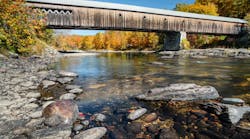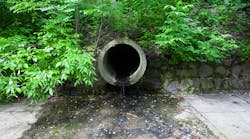In our previous article on per- and polyfluoroalkyl substances (PFAS) in stormwater, Geosyntec provided an overview of the state of our knowledge on PFAS prevalence in urban stormwater and its treatability by standard passive nature-based stormwater treatment controls, or green infrastructure, and active treatment systems (Stormwater, August 2020). This California-focused update is a follow-up to that article, focusing on the regulatory implications of PFAS in stormwater for permitted dischargers under the Clean Water Act (CWA).
Industrial Stormwater
Individual National Pollutant Discharge Elimination System (NPDES) permits, whether for wastewater or stormwater discharges, typically require monitoring for pollutants that are expected to be present in the discharge based on industrial activities at a facility. The CWA and its regulations broadly define regulated “pollutants” to include “dredged spoil, solid waste, incinerator residue, sewage, garbage, sewage sludge, munitions, chemical wastes, biological materials, radioactive materials, heat, wrecked or discarded equipment, rock, sand, cellar dirt and industrial, municipal, and agricultural waste discharged into water.” Due to this broad definition, PFAS compounds may qualify as “pollutants” under the CWA and be subject to applicable permitting requirements.
In California, it is common for NPDES permits to include numeric water quality-based effluent limits (WQBELs) for pollutants with concentrations measured above applicable water quality standards (WQS); this is referred to as the reasonable potential analysis process. Further, the California Industrial General Permit (IGP) requires a self-assessment to identify monitoring parameters, or “additional pollutants” beyond the minimum specified in the IGP (i.e., total suspended solids, pH, and oil and grease) or otherwise listed in the Standard Industrial Classification-based parameters. This process requires dischargers or their consultants to self-assess, through visual observation, their industrial activities and materials, the pollutants associated with these activities and materials, and the potential for exposure to rainwater and stormwater. This assessment is referred to as the pollutant source assessment (PSA) process. Under the PSA process, where industrial pollutants are potentially exposed, the IGP requires the sampling of stormwater discharges for them or surrogate indicator parameters. Depending upon the circumstances at a particular facility, this could extend to identifying PFAS compounds, which are not otherwise specifically listed in the IGP or as a SIC-based parameter, for sampling. Recent state legislation has been aimed at controlling PFAS at the source by requiring alternative manufacturing practices restricting the use of PFAS in consumer goods, thus reducing PFAS found in things like municipal solid waste. So the hope of stormwater dischargers is that these product changes over time translate to much less PFAS exposure to, and mobilization in, their stormwater discharges.
With PFAS, the potential sources are many (e.g., food packaging, waterproof textiles, carpets, cosmetics, biosolids); however, only those materials which meet the IGP definition of an “industrial material” and are exposed to rainwater or stormwater would trigger sampling for PFAS (except where the State Water Resources Control board [SWRCB] or Regional Water Quality Control board [RWQCB] has explicitly required additional parameters for sampling in issuing an NPDES permit). From the IGP Attachment C Glossary:
Industrial Materials includes, but is not limited to: raw materials, recyclable materials, intermediate products, final products, by-products, waste products, fuels, materials such as solvents, detergents, and plastic pellets; finished materials such as metallic products; raw materials used in food processing or production; hazardous substances designated under Section 101(14) of Comprehensive Environmental Response, Compensation, and Liability Act (CERLCA); any chemical the facility is required to report pursuant to Section 313 of Title III of Superfund Amendments and Reauthorization Act (SARA); fertilizers; pesticides; and waste products such as ashes, slag, and sludge and that are used, handled, stored, or disposed in relation to a facility’s industrial activity.
The IGP, through its receiving water limits, also requires stormwater discharges to not “cause or contribute” to exceedances of WQS in receiving waters. Currently, no WQS exist for PFAS. However, California drinking water standards (Maximum Contaminant Levels [MCLs]) are under development and the SWRCB expects these to be finalized around 2023. Existing drinking water notification levels and response levels (5.1 and 10 ng/L PFOA; 6.5 and 40 ng/L PFOS) provide an indication of future MCL values.
Ecological (aquatic life) and other human health criteria (for consumption of fish) will be developed next, and a potential preview of these can be found in the San Francisco RWQCB’s 2020 interim environmental screening levels (ESLs). In general, the ecological thresholds are higher than the drinking water thresholds. Human heath thresholds for consumption of fish are lower than both and, based on the ESLs, lower than analytical detection limits. For example, for PFOS, the ecological toxicity ESL for protection of aquatic life is 75 nanograms per liter (ng/L), the drinking water response level is 40 ng/L, drinking water notification level is 6.5 ng/L, the typical laboratory detection limit is around 1 ng/L, and the human health ESL for seafood ingestion is 0.0047 ng/L, well below the detection limit. Other ecological risk assessments, such as those recently produced through the Department of Defense’s Strategic Environmental Research and Development Program (SERDP), suggest higher thresholds for PFOS might be sufficiently protective of aquatic life (e.g., >5,000 ng/L; Conder et al. 2020; Zodrow et al. 2021) or wildlife (e.g., ~75 ng/L; Zodrow et al. 2021).
Once adopted by California, MCLs for PFAS will apply to discharges to waters of the state with municipal supply (MUN) beneficial uses designated, or with groundwater recharge uses and underlying groundwaters with MUN use designations. Ecological and human health seafood consumption criteria are expected to apply to all surface waters of the state. The beneficial use designations drive the applicability of WQS. Once WQS (or “objectives” in California) are effective, and effluent discharge and receiving water sampling occurs, a permittee (of any type — industrial, construction, or municipal) is potentially at risk of violating the NPDES permit’s receiving water limits if its effluent exceeds applicable WQS.
Municipal Stormwater
Municipal Separate Storm Sewer System (MS4) discharges in California are typically regulated under Phase 1 regional (multi-permittee) NPDES permits, the Phase 2 statewide general NPDES permit, or Caltrans’ statewide permit. Similar to the IGP and like most stormwater NPDES permits in California, the receiving water limits include requirements to “not cause or contribute” to WQS exceedances in receiving waters. Unlike the IGP though, there is no exception for pollutant responsibility based on whether sources are exposed to rainwater or stormwater and from industrial (or in this case, municipal) sources. Therefore, some MS4 permittees may have greater legal exposure for contributions to WQS exceedances (i.e., the applicable list of WQS would be broader).
Land use-specific stormwater PFAS studies indicate that PFAS stormwater concentrations from typical urban land uses may exceed potential future WQS values as reflected in recently published thresholds. For example, typical municipal stormwater PFAS concentrations reported in literature (including urban, residential, and commercial land uses) range from non-detect (ND) to 648 ng/L PFOS and 1.5 to 1,160 ng/L PFOA. The upper range of PFOS concentrations exceeds the human health and aquatic life ESLs listed above. Residential or urban concentrations range from 2.1 to 26 ng/L PFOS and 1.5 to 69 ng/L PFOA (Spahr et al., 2020; Codling et al., 2020; Houtz, 2013; ITRC, 2018; Lin et al., 2018; Xiao et al., 2012; Zushi et al., 2009; and Zushi et al., 2007). The upper range of PFOS concentrations falls below the aquatic life ESLs but above the human health ESLs.
Some MS4 permits include alternative compliance options in their receiving water limits that may provide some protection and flexibility for responding to PFAS concentrations in municipal stormwater. Notable examples include implementation-based options like implementing an approved Watershed Management Plan (in Los Angeles) or Water Quality Improvement Plan (in San Diego), which can function as a compliance schedule by setting implementation milestones and dates for completion. Recently proposed state legislation (AB 377), now modified, reflected an attempt to change or remove such options.
Additional Considerations
Current guidance for collecting PFAS samples includes multiple do’s and don’ts to avoid biasing sample results. PFAS are present in a wide array of commonly used field equipment and materials. PFAS can also preferentially sorb to materials, biasing sample results low. Direct contact of these PFAS-containing materials with the sample should be avoided. In addition, field blanks are typically collected to demonstrate adequacy of field procedures. For non-drinking water matrices, multiple analytical methods are available. PFAS are typically analyzed using liquid chromatography and tandem mass spectrometry (LC/MS/MS) consistent with United States (U.S.) Department of Defense (DoD) quality systems manual (QSM) criteria version 5.3 Table B-15. Standard EPA method 8327 has also been published but lacks isotope dilution and internal standards and is therefore considered to be a screening method. EPA is also working on a standard method for non-drinking water matrices that uses isotope dilution (SW-846). Because the state of knowledge on these topics is changing rapidly, it is recommended that interested parties contact multiple analytical laboratories or an experienced consultant for up-to-date information and guidance.
Conclusions
This article summarized various permitting and compliance frameworks and considerations for stormwater dischargers, and the range of potential future activities to address PFAS under each type of permit. PFAS is ubiquitous in urban stormwater and has been shown to be present at concentrations that are occasionally to often above pending WQS. Regardless of the type of permit and corresponding compliance options, permit non-compliance and Clean Water Act citizen suit risks are expected to be a risk for dischargers with PFAS in their stormwater.
Given the treatability challenges of this class of chemicals by conventional stormwater Best Management Practices, PFAS non-compliance and liability will be issues to anticipate and quickly respond to as new WQS are drafted and released for comment, and legislation-based source control efforts evolve. Meanwhile, as with other emerging contaminants (e.g., microplastics and the tire chemical breakdown product, 6PPD-quinone), stormwater dischargers should continue working closely with regulators to track emerging regulations and WQS. Researchers and practitioners will likely continue filling key knowledge gaps on PFAS in stormwater, including occurrence studies, sources, fate and transport, receptor risks, and treatability. Policy makers will likely continue to emphasize source control and other means of effectively balancing protection of receiving water beneficial uses with the cost and feasibility of stormwater controls. SW
Brandon Steets is a senior principal engineer with Geosyntec Consultants based in California with 20 years of experience specializing in NPDES and TMDL regulations, pollutant source investigation, water quality modeling and monitoring, stormwater BMP planning and design, and Clean Water Act litigation.
Elisabeth Hawley is a senior consultant at Geosyntec specializing in PFAS investigations, fate and transport, and remediation technologies.
Jennifer Arblaster is a project scientist with Geosyntec based in Vermont with eight years of experience in bioaccumulation modeling, ecological and human health risk assessment, sediment site characterization, and evaluation of environmental quality criteria.
Adam Questad is a senior engineer with Geosyntec based in Massachusetts with eight years of experience specializing in stormwater regulations and treatment, watershed management and planning, and industrial stormwater permitting and litigation.
Dr. Rula Deeb is a senior principal with Geosyntec based in California with more than 25 years of experience focused on private practice and academia addressing the cross-media fate and transport of emerging contaminants including PFAS and the remediation of complex soil and groundwater sites.
Tom Boer is a partner in San Francisco at Hogan Lovells U.S. LLP where his practice includes representing clients in compliance and litigation involving the Clean Water Act.
References
Conder, J.C., Arblaster, J.A., Larson, E.L., 2020. Guidance for Assessing the Ecological Risks of PFAS to
Threatened and Endangered Species at Aqueous Film Forming Foam Impacted Sites. SERDP Project: ER18-1614. September. www.serdp-estcp.org/Program-Areas/Environmental-Restoration/ER18-1614.
Codling, C., Yuan, H., Jones, P.D., Giesy, J.P., Hecker, M., 2020. Metals and PFAS in Stormwater and Surface Runoff in a semi-arid Canadian city subject to large variations in temperature among seasons. Environmental Science and Pollution Research 27: 18232–18241. DOI 10.1007/s11356-020-08070-2.
Houtz, E.F., 2013. Oxidative Measurement of Perfluoroalkyl Acid Precursors: Implications for urban runoff management and remediation of AFFF-contaminated groundwater and soil. PhD diss., UC Berkeley.
Interstate Technology Regulatory Council (ITRC), 2018. Environmental Fate and Transport for Per- and Polyfluoroalkyl Substances.
Lin, D., Sutton, R., Shimabuku, I. and Sedlak, M., 2018. Contaminants of Emerging Concern in San Francisco Bay: A Strategy for Future Investigations 2018 Update. SFEI Contribution No. 873. San Francisco Estuary Institute: Richmond, Calif. www.sfei.org/sites/default/files/biblio_files/CEC%20Strategy%20-%202018%20Update.pdf.
Spahr, S., Teixido, M., Sedlak, D.L. and Luthy, R.G., 2020. Hydrophilic trace organic contaminants in urban stormwater: Occurrence, toxicological relevance, and the need to enhance green stormwater infrastructure. Environmental Science: Water Resources Technology 6: 15-44. DOI 10.1039/C9EW00674E.
Xiao, F., Simcik, M.F. and Gulliver, J.S., 2012. Perfluoroalkyl acids in urban stormwater runoff: influence of land use. Water research, 46 (20): 6601-6608. DOI 10.1016/j.watres.2011.11.029.
Zodrow, J.M., Frenchmeyer, M., Dally, K., Osbore, E., Anderson, P. Devine, C. 2021. Development of Per and Polyfluoroalkyl Substances Ecological Risk‐Based Screening Levels. Environmental Toxicology and Chemistry, 40 (3): 921–936. DOI 10.1002/etc.4975.
Zushi, Y. and Masunaga, S., 2009. First-flush loads of perfluorinated compounds in stormwater runoff from Hayabuchi River basin, Japan served by separated sewerage system. Chemosphere 76 (6): 833-840. DOI 10.1016/j.chemosphere.2009.04.004.
Zushi, Y., Takeda, T., and Masunaga, S., 2007. Existence of nonpoint source of perfluorinated compounds and their loads in the Tsurumi River basin, Japan. Chemosphere 71 (8): 1566-73. DOI 10.1016/j.chemosphere.2007.11.055.
Published in Stormwater magazine, August 2021.






